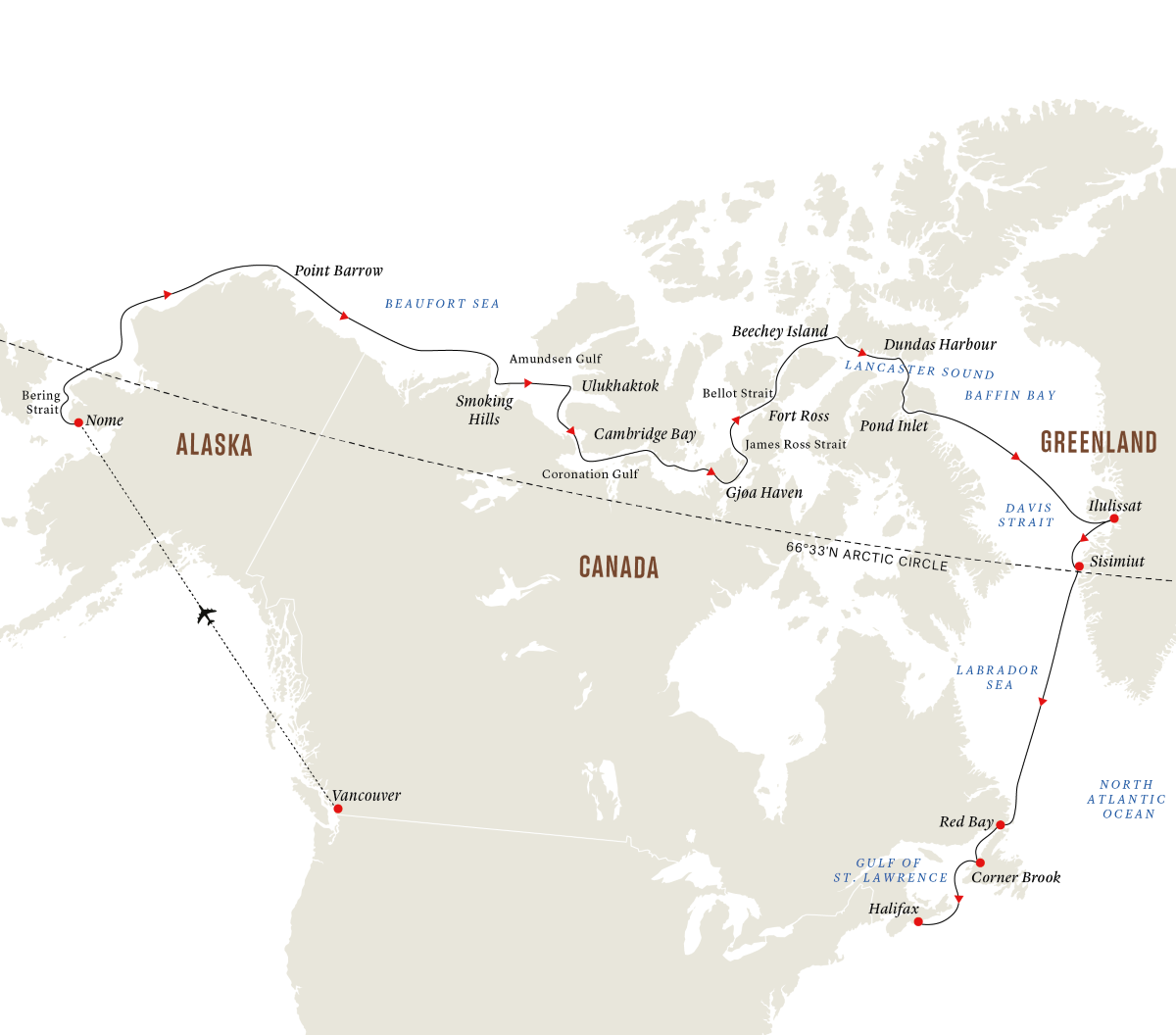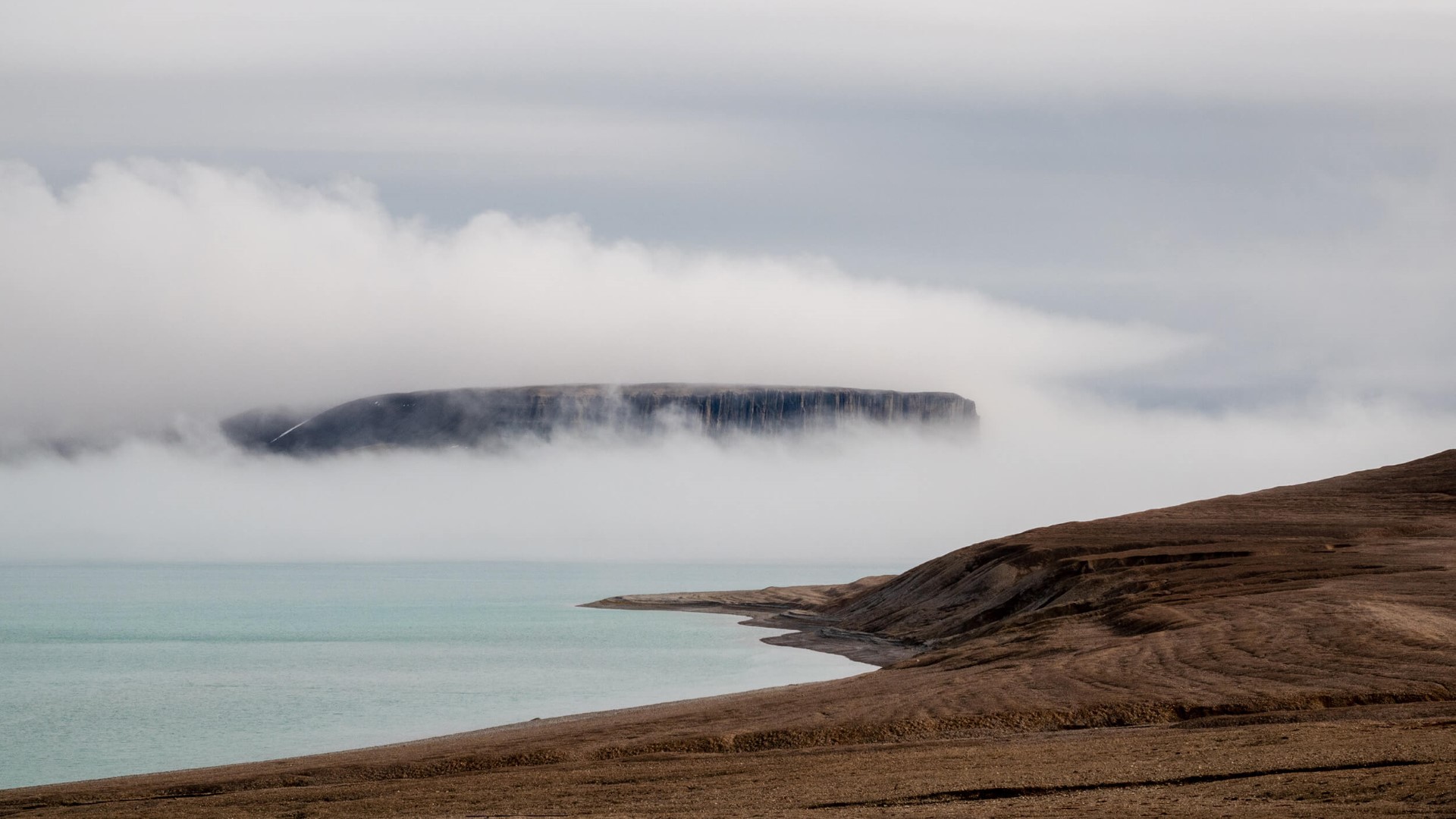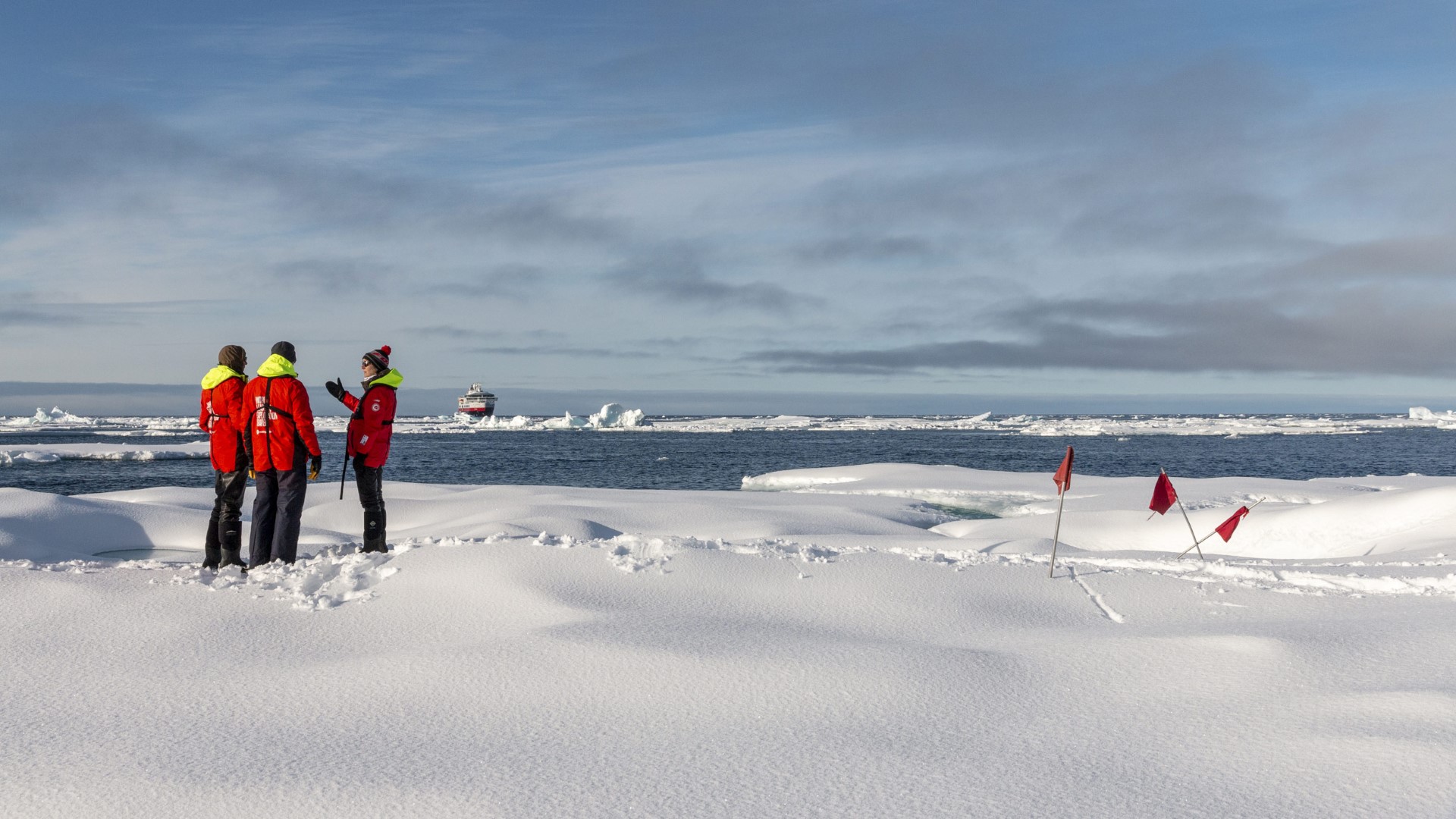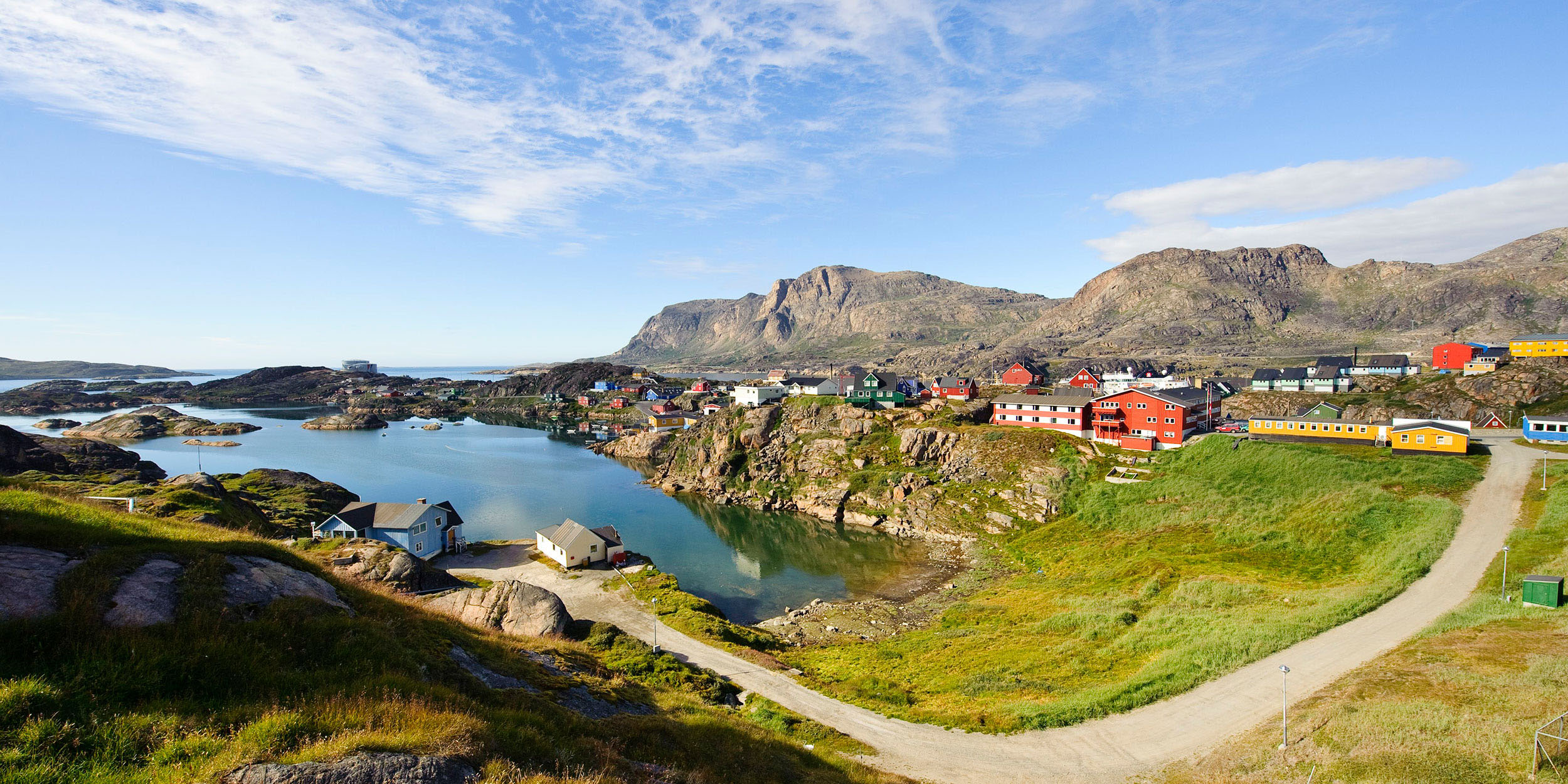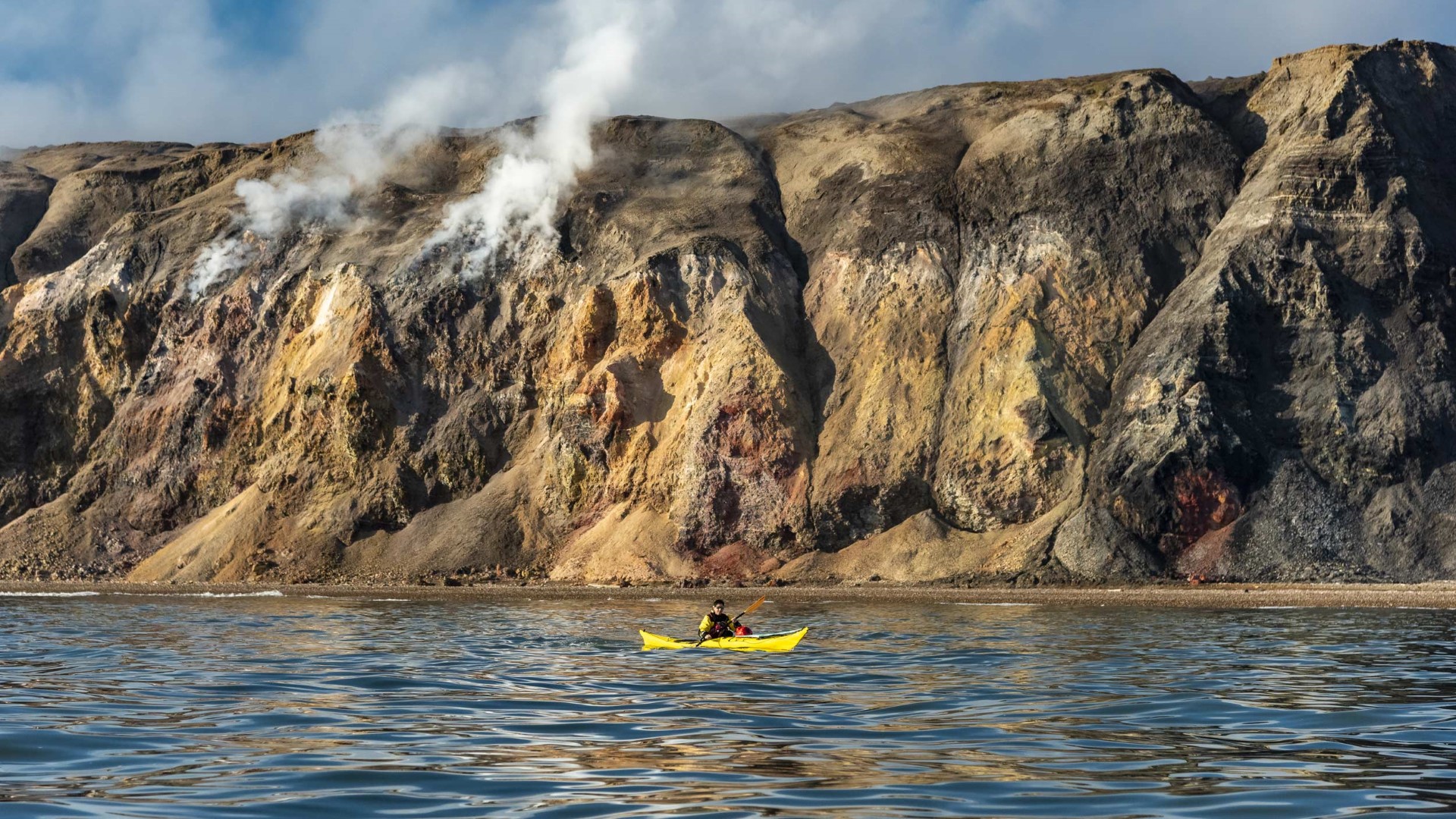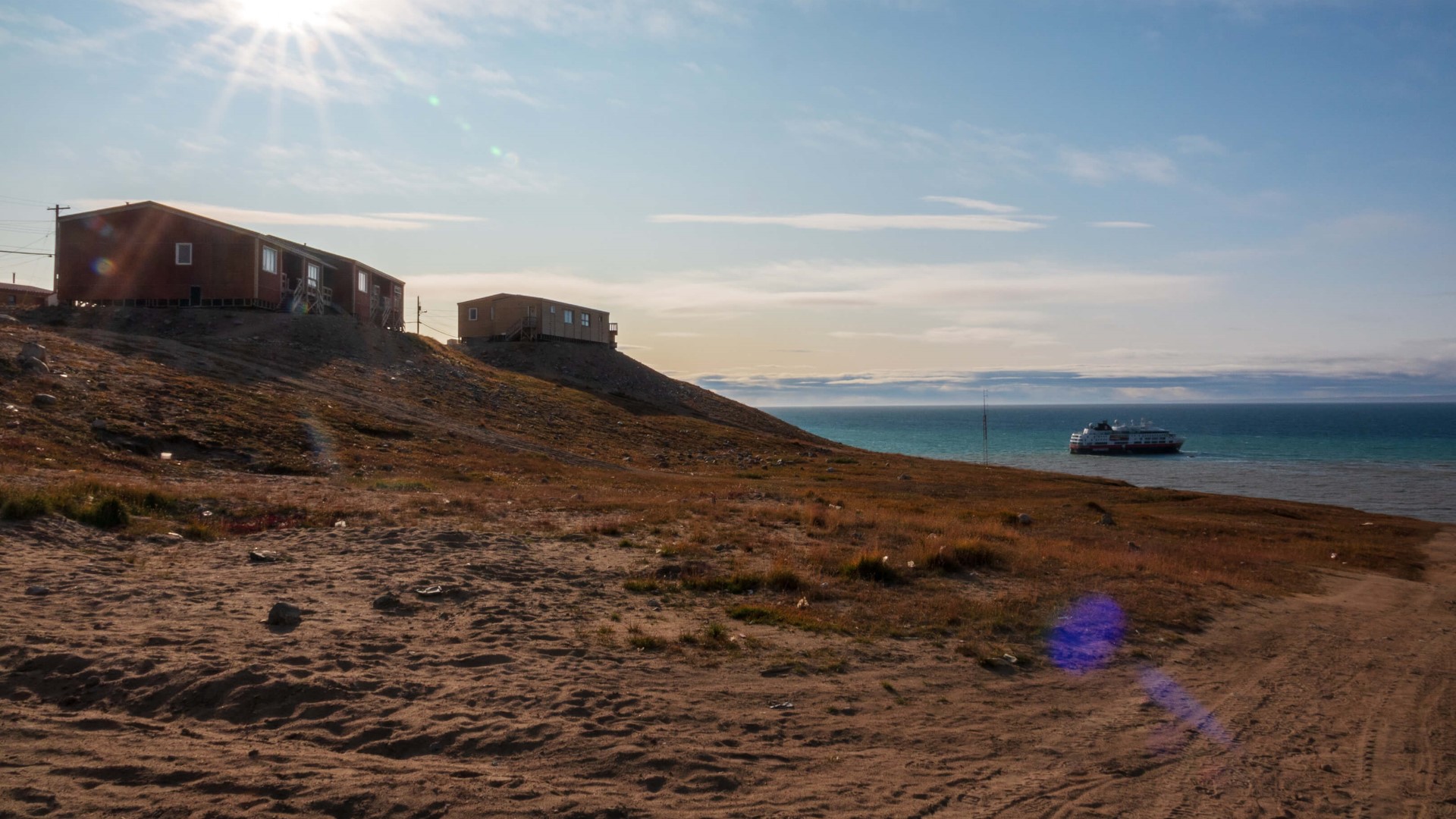Northwest Passage – In the Wake of Great Explorers
CAD $20,360
26 days / 25 nights
Embark on this expedition cruise attempt to sail all through the fabled Northwest Passage from Alaska all the way to Greenland and Nova Scotia.
Itinerary
Your expedition cruise starts in Vancouver. Set among beautiful mountain scenery and the waters of English Bay, Vancouver is both a bustling seaport and a cosmopolitan city. Arrive a few days ahead of the cruise to fully enjoy British Colombia’s largest city.
Its neighborhoods buzz with world-class farm-to-table cuisine. Chinatown and Punjabi Market have arguably the best Asian food in North America, while Commercial Drive is the home of Little Italy.
Don’t miss Vancouver’s oldest neighborhood! Gastown’s Victorian buildings house some of the city’s hottest restaurants, and its over 500 foot high Vancouver Lookout offers a perfect panorama.
Take in the neon lights and nightlife along the Granville Street strip or just relax on one of the beaches in West End. The latter is also the gateway to the greenery of Stanley Park, filled with wide-open spaces to explore.
For an easy way to enjoy the highlights of Vancouver, we offer a half-day Vancouver Sightseeing Tour as a Pre-Program. It even includes a trip to the thrilling Capilano Suspension Bridge, which hangs 230 feet over the river. Pining for an even wilder adventure? Sign up for the Pre-Program trip aboard the Rocky Mountaineer train! The scenery is nothing short of spectacular.
You’ll fly from Vancouver to Nome, where MS Roald Amundsen awaits you to start your expedition cruise.
Situated on the Seward Peninsula, Nome’s name went down in Alaska history the day the ‘Three Lucky Swedes’ discovered gold in Anvil Creek in 1898. Prospectors soon flocked from the Yukon and from San Francisco by steamboat. Even the famous sheriff Wyatt Earp chased the call of gold and opened a saloon here. Leftovers from Gold Rush era are everywhere, from abandoned dredges to turn-of-the-century steam engines and old railroad tracks. Cries of “Gold! Gold!” can still be heard today by those foraging on the banks of the Snake River and elsewhere in the area.
The town also marked the end point of three of Roald Amundsen’s great expeditions: the Northwest Passage in 1906, the Northeast Passage in 1921, and an attempt to reach the North Pole by aircraft in 1926.
It’s only fitting that you’ll board an expedition ship bearing his name here in Nome, eagerly embarking on your own adventure across the Arctic.
During your first days at sea, the excitement of the journey will slowly simmer with adventure on the horizon. Exploring the ship is a must, with plenty of onboard facilities to enjoy, like the infinity pool, hot tubs, sauna, indoor gym, outdoor running track, and spa.
You can also sit in on the Expedition Team’s informative lectures in the Science Center. Each topic, which can range from wildlife to tectonic activity, glaciology, or local history and culture, is designed to help you appreciate the areas we sail through and inform you ahead of upcoming landings.
The Expedition Team will also review important guidelines from AECO, the Association of Arctic Expedition Cruise Operators. You’ll learn how you can protect wildlife habitats, keep a safe distance from animals, and visit Arctic communities in a proper and respectful way.
As we sail through the Bering Strait, look to the sky to spot a range of seabirds. There are over 30 species to spot, including Black-legged Kittiwakes and different species of auklets and murrelets. More than 10 million of these winged wonders visit the region in late summer, so you’ll get plenty of use from your binoculars.
Through the Bergin Strait, you’ll have Russia to the west and the U.S. to the east. This is the international date line, where ‘tomorrow’ rests to your left and ‘today’ to the right.
After crossing Chukchi Sea, we reach the northernmost point of the U.S. at Point Barrow and enter the Beaufort Sea. Keep an eye on the waters here for bowhead and gray whales—we might also start seeing sea ice.
Then it’s into Amundsen Gulf, where we hope to observe the remarkable and colorful Smoking Hills. It’s an amazing sight, with smoke billowing from the cliffs on the east coast of Cape Bathurst. Lignite (a combination of eroded shale and pyrite) spontaneously ignites when exposed to air, creating this photogenic phenomenon.
The time has come for us to attempt a complete transit of the Northwest Passage. Not counting us, only around 60 expeditions have tried to navigate this seaway, with the earliest attempts dating as far back as 1497.
James Cook attempted it in 1776 and many may have heard about the ill-fated Franklin expedition of 1845. The first to conquer the Northwest Passage by ship was Norwegian explorer Roald Amundsen on an expedition lasting from 1903 to 1906, aboard the converted herring boat, the Gjøa.
We’ll enter the Northwest Passage on our own adventure aboard a state-of-the-art expedition ship named in Amundsen’s honor, aiming to sail through to Greenland and Eastern Canada.
We will land at sites linked to early exploration history, visit Inuit communities, and hope to spot Arctic wildlife such as polar bears, whales, seals, and a variety of seabirds.
Opportunities will open for small-boat (RIB) cruising between ice floes, and in true expedition style, we’ll go ashore and experience the pristine wilderness first hand.
The captain and Expedition Leader will continuously assess the weather and sea conditions and adapt the activities accordingly, adjusting the itinerary to where the sea ice allows us to go. Like all good explorers, we respect and work with nature, never against it.
Here are some of the places in the region that we hope to explore during landings and short walks—wind, waves, and sea ice permitting.
Ulukhaktok
Many in the 500-people strong community are involved in the local artists’ co-op and produce prints, tapestries, and other handicrafts. This is also home to the world’s northernmost golf course, which hosts a tournament every summer.
Cambridge Bay
Located on Victoria Island, this is the largest stop for vessels traversing the Northwest Passage. It is also called ‘Iqaluktuuttiaq’ (‘A Good Fishing Place’) due to the Ekalluk River, which attracts Arctic char, musk oxen, and caribou.
Gjoa Haven
Norwegian explorer Roald Amundsen wintered at this hamlet in 1903, on the expedition the ‘haven’ is named after. During his time here, he learnt crucial survival skills from the local Netsilik Inuit people. This knowledge would later give him the upper hand in his famous race to the South Pole in 1911. There is an informative walking tour, a Heritage Center, and a Hamlet Center dedicated to the history and culture of the area.
Fort Ross
Fort Ross has an abandoned Hudson’s Bay Trading post located at the southern end of Somerset Island. The storehouse here is still occasionally used as a shelter by travelers, with bunk beds and shelves of canned goods.
Beechey Island
This is the final resting place for three members of the lost Franklin expedition, which sailed into the Northwest Passage in 1845, never to return. It is customary for explorers in the region to stop and pay their respects at the graves, as Roald Amundsen did in 1903.
Devon Island
Welcome to the largest uninhabited island on Earth. The only signs of human life are at the long-abandoned settlement of Dundas Harbour, along with several archeological sites from the Thule period.
Pond Inlet
Called ‘Mittimatalik’ in Inuktitut, it means ‘the place where the landing place is’. This is a traditional Baffin Island Inuit community that enjoys views of the Eclipse Sound and the mountains of Bylot Island. It’s also known as a great place to see narwhal—the unicorn of the sea.
It’s time to leave Canada behind and set course for Greenland. While sailing across Baffin Bay and Davis Strait, don’t miss the ongoing informative lectures in the Science Center. The topics may include the wildlife you could spot, Greenlandic culture, expedition history, geology, photography, and famous historic explorers.
Feel like being more active? Hit up the gym and get your blood pumping. Don’t forget you’ll have access to the sauna, an infinity pool, and two outdoor hot tubs. Enjoy drinks in the panoramic Explorer Lounge & Bar, while settling down into a sofa and letting the rhythmic waves of the ocean roll by.
In the evening, swap adventure stories with the Expedition Team and learn more about these modern-day explorers. Each of them are treasure troves of adventure and information.
Ilulissat (translated simply as ‘Icebergs’) is set in the stunning scenery of the Ilulissat Icefjord, a UNESCO World Heritage Site. This beautiful gem of a town stands out for its colorful houses sitting along the fjord, which features an ever-changing gallery of icebergs. This place is truly picture perfect.
It’s also a vibrant hub for adventure seekers who head out onto the polar ice sheet. There are almost as many sled dogs living here as there are people. Each spring, one of the world’s greatest dog-sled races takes place here, with 100 sleds participating.
Just outside the town, you can often see enormous icebergs floating in the deep blue waters. They originate from the Jakobshavn Glacier, which calves some 35 billion tons of icebergs each year. The icebergs make their way down the 12-mile fjord before entering Disko Bay. They are a nature photographer’s dream.
You won’t just see these chiseled masses of ice up close, you’ll also hear them. Their cracks, rumbles, and creaks echo throughout the fjord as they bump into one another and into the shores.
If that background noise is like the drums, the crumble, crash, and splash of ice calving off the icebergs into the waters below are the cymbals. Take a moment to sit, watch, and listen to the icebergs in these beautiful surroundings.
Located in a spectacular setting, Greenland’s second-largest city, Sisimiut, sits 25 miles north of the Arctic Circle in the central coastal area of the Davis Strait. It’s a modern settlement, but its roots stretch far back, with some estimates dating more than 4,500 years.
Its name translates into ‘the people at the fox holes’, a reference to the many Arctic fox burrows that lie near the city. Another local animal is the musk ox, whose wool is used to make a local fabric called qiviut—said to be 10 times warmer than sheep wool. Think about picking up a qiviut scarf, hat, or mittens while you’re here.
With a population of around 5,500, Sisimiut is an important regional hub. Boats heading between Nuuk and Disko Bay area frequently use it as a stopover point, with many coming to practice backcountry sports like skiing or dog sledding on the Greenland ice sheet.
The small museum houses artifacts from excavations of ancient Saqqaq settlements near the town, some up to 4,000 years old. Don’t miss the Taseralik Cultural Center, the perfect place to learn about the area’s cultural heritage.
Relax, get to know your fellow travelers, and make full use of the onboard facilities. In the Science Center, the Expedition Team’s lecture program focuses on the wildlife and ecosystems of the Arctic.
We also support a number of Citizen Science projects that you can join. These include the Happywhale project, where your photographs help identify and track the movement of specific whales across the planet, identified from their distinguishing characteristics.
You may also join the GLOBE Observer project, which combines your observations of clouds and sky conditions with satellite data.
By participating in these projects, not only will you be supporting the scientific community, you’ll also be gaining a better understanding of the world around you.
Red Bay is a former Basque whaling settlement on the coast of southern Labrador in the Strait of Belle Isle. You might catch a glimpse of humpback or minke whales, which first drew Basque whalers to this harbor in the 17th century. For about 70 years, these fishermen caught whales and exported their refined oil back to Europe.
But not all the whaling ships were able to reach Red Bay’s shores. Wrecked chalupas and galleons are just some of the ships that have been found preserved in the ice-cold waters. These discoveries make Red Bay one of the most important underwater archeological sites in the world.
On your visit to this fascinating town, make sure to visit the local museum, which is part of the Red Bay National Historic Site. Here, you can see an 26-foot chalupa (a small whale-catching boat) and imagine life as a Basque whaler on the Labrador Sea.
You can also look for whale bones in the protected National Historic Site or search for the buried treasure of pirate Captain Kidd around Tracey Hill. You might not find any gold doubloons, but you’ll certainly be rewarded with a fantastic view.
As you sail into the Bay of Islands, surrounded by the jagged slopes and dense forests of the Long Range Mountains, you’ll chart the same course as Captain James Cook over 250 years ago.
Just like that esteemed captain, our destination is Corner Brook, located at the mouth of the Humber River. This is the second-largest city in the Newfoundland and Labrador province, after St. John’s. While St. John’s is trendy and international, Corner Brook is definitely traditional and local.
The Corner Brook Museum will give you a great sense of the regional history. There are a number of artifacts from the indigenous cultures, the logging industry, and of course, Captain James Cook. One particularly fascinating exhibit is on World War II brides from England and Scotland.
We offer an optional excursion up to Crow Hill, home of the Captain James Cook National Historic Site. Standing where the famous British Explorer once stood to survey the area, you’ll have pleasant views over the city. Make sure to grab a photo with the statue of the man himself.
Other optional excursions include a guided hike along a portion of the Corner Brook Stream Trail. Or get your adrenaline flowing by zip-lining high up over the scenic Humber Valley while admiring views of Marble Mountain and Steady Brook Falls.
When the time comes to set sail again, a local band might just come aboard and treat us to a performance, sending us off with true Corner Brook hospitality.
It’s our final day at sea and your expedition cruise is drawing to a triumphant close. You might like to spend this day at sea just fully unwinding from the excitement of the past two weeks.
Your thoughts might naturally turn to home, or maybe you’ll find that you’ll have already left a piece if your heart back in one of the special places you visited. Spend some time reflecting on and taking stock of all the wonderful experiences you’ve had.
The Expedition Team will likely be in a similar mood. Join them as they fondly recap the highlights of the thrilling cruise we’ve shared together. You’ll probably have a few hundred photos to sift through of the scenic landscapes, activities, and memories you’ve experienced!
Your exciting, epic journey from one end of the Northwest Passage to other ends triumphantly in Halifax.
This cosmopolitan capital of the Canadian province of Nova Scotia sits in the center of the region’s east coast. This important seaport looks out over one of the world’s largest natural harbors.
With its red-brick heritage buildings, the landmark Citadel Hill National Historic Site, a historic 1820 brewery, and the epic 2.5-mile seafront boardwalk, Halifax has plenty in store if you feel like extending your trip.
Near our docking site, you’ll find is Pier 21, the ‘Ellis Island of Canada,’ where thousands of immigrants arrived from all over the world. It’s the perfect place for Canada’s Museum of Immigration. You can also visit the Maritime Museum of the Atlantic, which contains a large exhibit on the notorious Titanic disaster.
Not far from Downtown Halifax is Halifax Common, which is Canada’s oldest park, opened in 1763. If you enjoy art, don’t miss the Art Gallery of Nova Scotia’s extensive collection.
We recommend spending a few extra days here on our Post-Program before heading back home. You’ll visit the historic community of Peggy’s Cove and see its iconic lighthouse. And pay your respects at Halifax Fairview Lawn Cemetery, the solemn burial place of 121 tragic passengers of the Titanic.
Dates & Prices
| Start/End | Nights | Sailing Schedule | Starting From |
|---|---|---|---|
| Vancouver / Halifax | 25 | August 18, 2023 | $28,030 |
* Price per person based on double occupancy. Due to the dynamic nature of availability and pricing, please click here to contact us directly for sailing schedule and full pricing.
Featured Inclusions

Overnight in Vancouver before the expedition cruise including breakfast

Coach-class flight from Vancouver to Nome

Transfer from the hotel in Vancouver to the airport before the expedition cruise

Transfer from the airport to the ship in Nome before the expedition cruise

Expedition cruise in a cabin of your choice

Breakfast, lunch, and dinner including beverages (house beer and wine, sodas, and mineral water) in restaurants Aune and Fredheim

Complimentary tea and coffee

Experts on the Expedition Team deliver in-depth lectures on a variety of topics

Escorted landings with small explorer boats
Ship Information
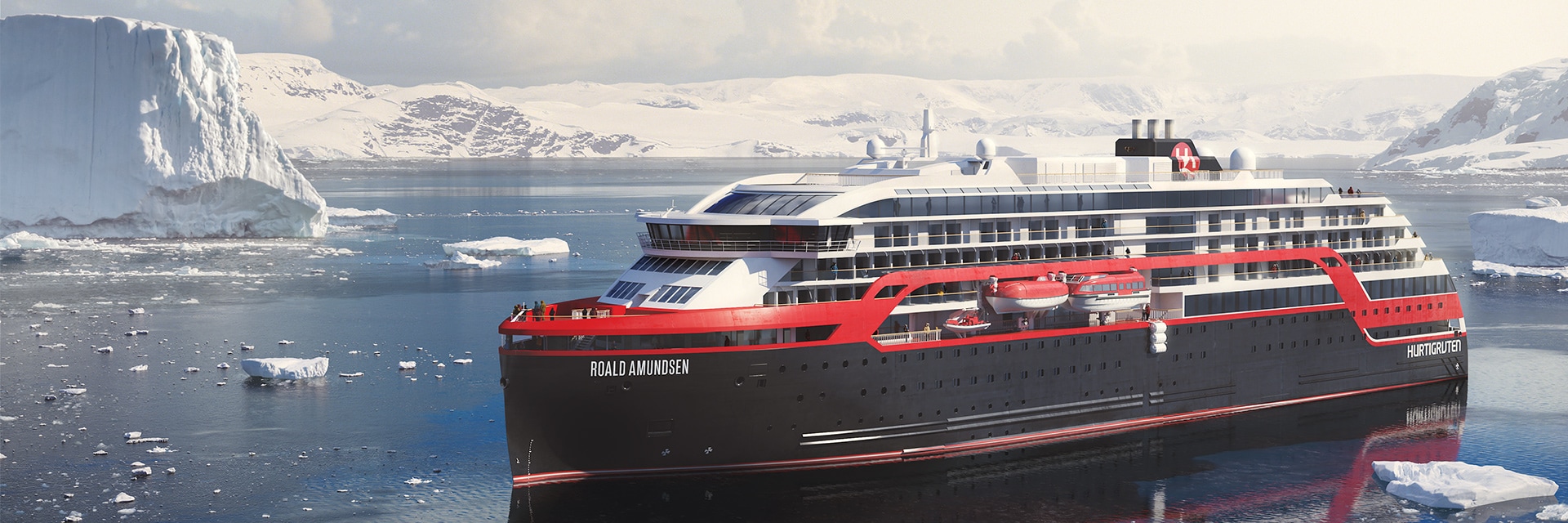
MS Roald Amundsen
MS Roald Amundsen is the first of two hybrid ships Hurtigruten will add to its fleet over the next few years, cutting emissions by sailing with electrical propulsion. Hybrid technology, combined with the advanced construction of the hull and effective use of electricity on board, will reduce fuel consumption and CO2-emissions on the ships by 20%. The building of these two ships represents the largest single investment in the history of Hurtigruten.

